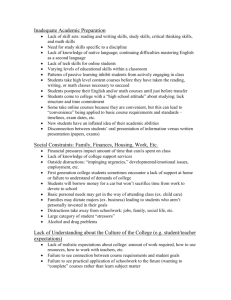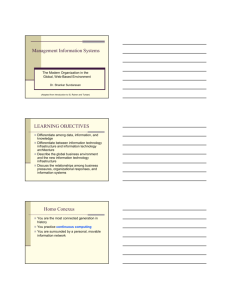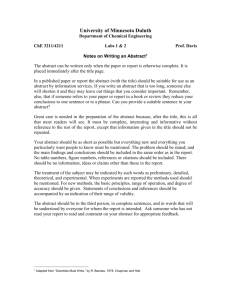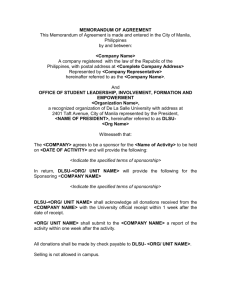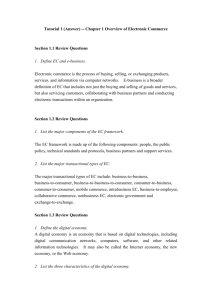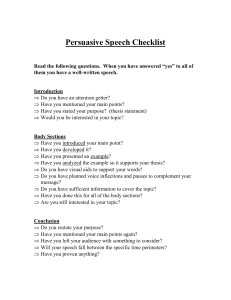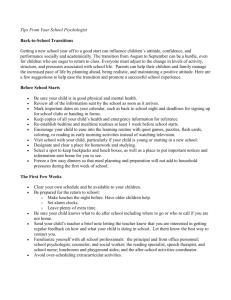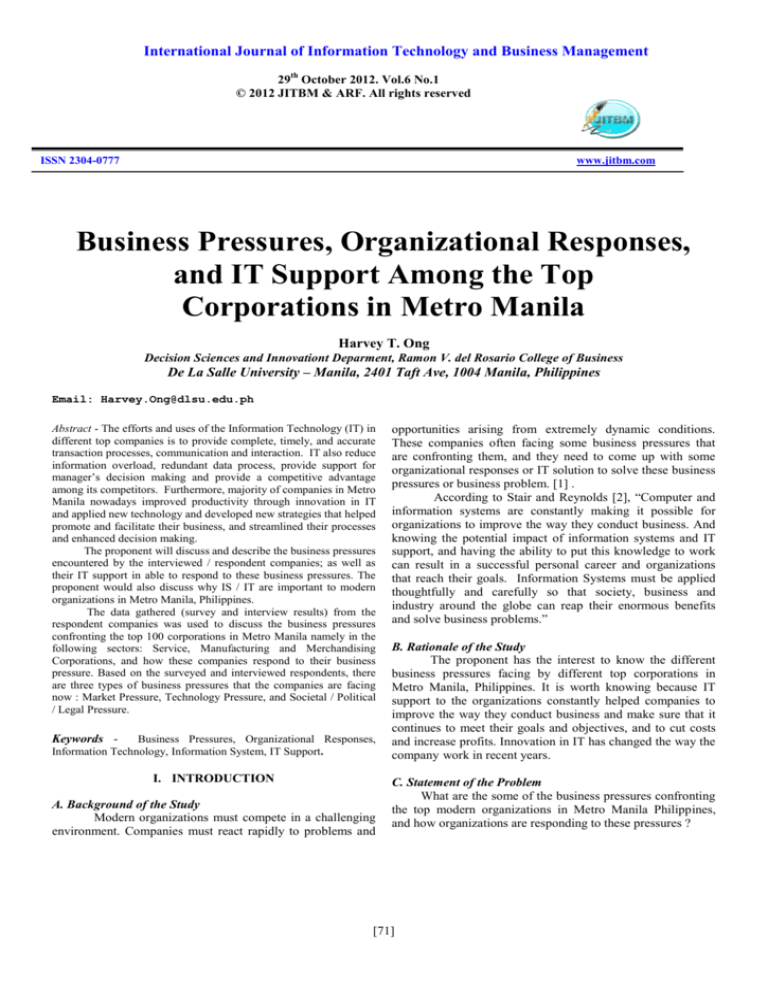
International Journal of Information Technology and Business Management
29th October 2012. Vol.6 No.1
© 2012 JITBM & ARF. All rights reserved
ISSN 2304-0777
www.jitbm.com
Business Pressures, Organizational Responses,
and IT Support Among the Top
Corporations in Metro Manila
Harvey T. Ong
Decision Sciences and Innovationt Deparment, Ramon V. del Rosario College of Business
De La Salle University – Manila, 2401 Taft Ave, 1004 Manila, Philippines
Email: Harvey.Ong@dlsu.edu.ph
Abstract - The efforts and uses of the Information Technology (IT) in
different top companies is to provide complete, timely, and accurate
transaction processes, communication and interaction. IT also reduce
information overload, redundant data process, provide support for
manager’s decision making and provide a competitive advantage
among its competitors. Furthermore, majority of companies in Metro
Manila nowadays improved productivity through innovation in IT
and applied new technology and developed new strategies that helped
promote and facilitate their business, and streamlined their processes
and enhanced decision making.
The proponent will discuss and describe the business pressures
encountered by the interviewed / respondent companies; as well as
their IT support in able to respond to these business pressures. The
proponent would also discuss why IS / IT are important to modern
organizations in Metro Manila, Philippines.
The data gathered (survey and interview results) from the
respondent companies was used to discuss the business pressures
confronting the top 100 corporations in Metro Manila namely in the
following sectors: Service, Manufacturing and Merchandising
Corporations, and how these companies respond to their business
pressure. Based on the surveyed and interviewed respondents, there
are three types of business pressures that the companies are facing
now : Market Pressure, Technology Pressure, and Societal / Political
/ Legal Pressure.
Keywords -
Business Pressures, Organizational Responses,
Information Technology, Information System, IT Support.
I. INTRODUCTION
A. Background of the Study
Modern organizations must compete in a challenging
environment. Companies must react rapidly to problems and
opportunities arising from extremely dynamic conditions.
These companies often facing some business pressures that
are confronting them, and they need to come up with some
organizational responses or IT solution to solve these business
pressures or business problem. [1] .
According to Stair and Reynolds [2], “Computer and
information systems are constantly making it possible for
organizations to improve the way they conduct business. And
knowing the potential impact of information systems and IT
support, and having the ability to put this knowledge to work
can result in a successful personal career and organizations
that reach their goals. Information Systems must be applied
thoughtfully and carefully so that society, business and
industry around the globe can reap their enormous benefits
and solve business problems.”
B. Rationale of the Study
The proponent has the interest to know the different
business pressures facing by different top corporations in
Metro Manila, Philippines. It is worth knowing because IT
support to the organizations constantly helped companies to
improve the way they conduct business and make sure that it
continues to meet their goals and objectives, and to cut costs
and increase profits. Innovation in IT has changed the way the
company work in recent years.
C. Statement of the Problem
What are the some of the business pressures confronting
the top modern organizations in Metro Manila Philippines,
and how organizations are responding to these pressures ?
[71]
International Journal of Information Technology and Business Management
29th October 2012. Vol.6 No.1
© 2012 JITBM & ARF. All rights reserved
ISSN 2304-0777
www.jitbm.com
D. Objectives of the Study
The general objective of the study is to enumerate and
describe the business pressures confronting the 86
corporations in Metro Manila, Philippines, and to determine
the organizational responses and IT support adapted by these
86 corporations in Metro Manila in responding to all those
business pressures.
E. Scope and Limitation
The respondent of this research study will be limited to
86 corporations in Metro Manila, Philippines.
The data gathering was assisted by proponent’ students in
Business Management Information System class (1 st term AY
2009-2010), and it was limited to 100 top corporations based
on their gross revenue in Metro Manila, Philippines which
was stated in Business World Magazines (Volume 22)
published early 2009. Business World Top 1000 Corporations
in the Philippines is published annually by Business World
Publishing Corporation, with editorial offices at 95 Balete
Drive Extension, New Manila, Quezon City, Metro Manila,
Philippines.
At first, the limitation of the study was limited to top
100 corporations based on their gross revenue which was
stated in Business World magazines, but unfortunately, not all
the 100 corporations responded. Some of them are not willing
to be surveyed nor interviewed. Out of 100, only 86
corporations responded. In addition, only these 86 companies
were accessible and located in Metro Manila.
The respondent also had a hard time to assess the data
gathered from the companies. The data gathered was
presented in narrative explanation format, this give the
proponent a hard time in coding the data. Another limitation
of the study was that there are some business pressures, IT
supports and other important details and information were not
mentioned or discussed clearly by the interviewee respondent
of the corporation. And many companies also claimed that
these information are kept confidential by their companies.
organizations. Organizations typically respond to these
pressures with activities supported by IT.”
Figure 1 shows the relationships among business
pressures, organizational performance and responses, and IT
support. Here we focus on three types of business pressures
that organizations face : market, technology and societal
pressures. Organizations responding to these business
pressures by implementing IT.
Fig. 1 : Schematic Diagram of the Conceptual Framework
B. Operational Framework
Adopted from the Conceptual Framework of Rainer and
Turban (2009), the Business Pressures and Organizational
Responses will serve as the variables of this study in terms of :
II. FRAMEWORK
A. Conceptual Framework
The conceptual framework of the study is based on (or
adopted from) Rainer and Turban [1] which states the
following : “The business environment is the combination of
social, legal, economic, physical, and political factors that
affect business activities. Significant changes in any of these
factors are likely to create business pressures on
[73]
International Journal of Information Technology and Business Management
29th October 2012. Vol.6 No.1
© 2012 JITBM & ARF. All rights reserved
ISSN 2304-0777
www.jitbm.com
pharmaceutical, pediatric nutrition, cement, packaging
companies. And 36 companies (or 41.86 %) were
merchandising companies which include shopping and retail,
supermarket, warehousing, beauty products, LPG and
Petroleum companies.
(A) Business Pressures
(1) Market Pressure
Global Economy and Strong Competition
Changing Nature of the Workforce
Powerful Customers
Need for Real Time Operations
(2) Technology Pressure
Technological Innovation and
Obsolescence
Information Overload
(3) Societal / Political / Legal Pressures
Social Responsibility
Compliance with Government Regulations
And Deregulations
Protection against Terrorist Attacks
Ethical Issues
B. Sampling Plan
The secondary data collected during 1st term Academic
Year 2009-2010 from the corporation interviewed by
BUSIMIS students as the basis of data for this research study.
C. Method of Data Analysis
Primary data was tabulated in a data set, and the data
was analyzed using the frequency and percentage distribution.
Since the data gathered presented in narrative paragraph form,
content analysis will be used by the proponent in coding the
data. And the data was presented also in frequency
distribution table format and context narrative discussion.
(B) Organizational Responses
Strategic Systems
Customer Focus and Service
Continuous Improvement Efforts
Business Process Reengineering
Business Alliances
E-Business and E-Commerce
Better Data Management
IV. RESEARCH FINDINGS
The purpose of using the conceptual framework stated
in the previous section is to determine the business pressures
encountered, and organizational responses adapted by
different corporations in Metro Manila. This would also
describe the social context and corporate culture of the
companies studied – the values and beliefs that determine
what is admissible and possible within the culture of their
corporations involved.
Fig. 2 : Variables of the study
A. Business Pressures
III. RESEARCH METHODOLOGY
A. Research Design
The research design used was descriptive. The data
gathered (survey and interview results) from the respondent
companies will used to discussed and described about what
Business Pressures encountered by 86 corporations in Metro
Manila, as well as their Organizational Responses and IT
Support.
Among the 150 list of corporations, only 86 companies
responded. 38 companies (or 44.19 %) were Service
companies which includes oil refineries, electric distribution,
wireless service, banking, power service, port management,
media,
financial
institution,
utility,
real
estate,
telecommunications, transportation, infrastructure, water, call
center, and insurance companies. 12 companies (or 13.95 %)
responded were Manufacturing companies which includes
food, automotive, agriculture, beverage and beers,
TABLE 1 :
FREQUENCY AND PERCENTAGE DISTRIBUTION RESULTS
WITH REGARDS TO MARKET PRESSURES
Frequency
(n = 86)
77
%
1. Global Economy and Strong
89.5 %
Competition
2. The Changing Natures of the
24
27.9 %
Workforce
3. Powerful Customers
33
38.4 %
4. Need for Real Time Operations
21
24.4 %
In table 1, it shows that 77 out of 86 respondents (or
89.5 %) mentioned that the business pressure that they’re
facing right now was the global economy and strong
competition. They mentioned that they need to have a better
telecommunications system which can respond to their
[74]
International Journal of Information Technology and Business Management
29th October 2012. Vol.6 No.1
© 2012 JITBM & ARF. All rights reserved
ISSN 2304-0777
www.jitbm.com
globalization pressures. They have a lot of strong competitors,
it increased competition for market share and labor resources.
33 out of 86 respondents (or 38.4%) mentioned that
they have powerful customers. Customers are now more
demanding, they ultimately want detailed information about
products and services. They expect to have products and
service with high quality and low cost, at the same time,
product which is “free, perfect, and now”.
While 24 respondents (or 27.9 %) mentioned
changing natures of the workforce. Work force is changing
rapidly and becoming more diversified, many organization are
becoming transnational.
And 21 respondents (or 24.4 %) mentioned that they
need for real time operations. Respondents mentioned that
their companies sometimes has the problem of “information
float”, they need high-performance telecommunication
technologies to reduce time lag. Many of the companies still
experienced slow, paper-based, manual and mail-based
transactions.
TABLE 2
FREQUENCY AND PERCENTAGE DISTRIBUTION RESULTS
WITH REGARDS TO TECHNOLOGY PRESSURES
1. Technological Innovation
and Obsolescence
2. Information Overload
Frequency
(n = 86)
61
%
70.9 %
9
10.47 %
In table 2, it shows that 61 out of 86 respondents (or
70.9 %) mentioned that they are now facing technology
pressures of Technological Innovation and Obsolescence. The
companies are being pressure to have faster obsolescence or
products, shorter life cycles, increasing quality standards and
etc. They are forced to experiment and continuing innovation
with computer technologies.
While 9 respondents (or 10.47 %) mentioned that they
have Information Overload problem in their company. The
respondents
mentioned
that
Internet
and
other
telecommunication networks have now increase the amount of
information available to organization and individual. Many of
their managers and employees are at a risk of “analysis
paralysis” – which is bombarded with so much potentially
useful information. That they feel compelled to consider vast
amounts of it before taking action.
FREQUENCY AND PERCENTAGE DISTRIBUTION RESULTS
WITH REGARDS TO SOCIETAL / POLITICAL / LEGAL
PRESSURES
Frequency
(n = 86)
36
18
%
1. Social Responsibility
41.9 %
2. Compliance with
20.9 %
Government Regulations
and Deregulations
3. Protection against Terrorist
5
5.8 %
Attacks
4. Ethical Issues
15
17.4 %
In table 3, it shows that 36 out of 86 respondents (or
41.9 %) mentioned that they have Societal / Political / Legal
Pressure of Social Responsibility. They mentioned that they
have some social issues affecting their corporation. Some
corporations were failed to accept Social Responsibility
which result in employee dissatisfaction, a tarnished
corporation reputation with the public, and some government
sanctions.
Rank number 2, 18 out of 86 respondents (or 20.9 %)
mentioned that they have compliance problem with
government regulations and deregulations. They encountered
some difficulties in terms of compliance to the government
policies.
15 respondents (or 17.4 %) mentioned that they have
some Ethical Issues problems. They mentioned that the use of
I.T. is raising many new ethical issues, ranging from
surveillance of email to the potential invasion of privacy of
millions of customers whose data are stored in private and
public databases, hacking issues, using of piracy software,
violations of e-commerce law and etc.
And 5 respondents (or 5.8 %) mentioned about
protection against terrorist attacks. Since Sept. 11, 2001, many
organizations in USA have been under increased pressure to
protect themselves against terrorist attacks. And in
Philippines, the companies in Metro Manila also has the fear
of being hacked, they want to protect their system by
providing security systems, surveillance cameras that will help
them to prevent cyber-attacks.
TABLE 3
[75]
International Journal of Information Technology and Business Management
29th October 2012. Vol.6 No.1
© 2012 JITBM & ARF. All rights reserved
ISSN 2304-0777
B.
www.jitbm.com
Organizational Responses
TABLE 4
FREQUENCY AND PERCENTAGE DISTRIBUTION RESULTS
WITH REGARDS TO THE
ORGANIZATIONAL RESPONSES BY THE COMPANIES
1. Strategic Systems
2. Customer Focus and Service
3. Continuous Improvement
Efforts
4. Business Process
Reengineering
5. Business Alliances
6. E-Business and E-Commerce
7. Better Data Management
8. Others
Frequency
(n = 86)
30
52
27
%
34.9 %
60.5 %
31.4 %
9
10.5 %
19
8
12
25
22 %
9.3 %
13.5 %
29.1 %
In table 4, it shows that highest frequency count was 52, 60.5
% respondents mentioned customer focus and service. The
companies paying more attention to customer and their
preferences, they use all the efforts in meeting their customer
demands. They even provide trouble shooting advise or help
lines, and use IT to support customer service.
Rank number 2, 30 out of 86 respondents (or 34.9%)
mentioned that they used Strategic Systems approach to solve
their business problems. This would able to provide the
organizations with strategic advantages in meeting their
organizational objectives, enabling them to increase their
market share, to better negotiate with their suppliers, or to
prevent competitors from entering their markets.
Third highest, 27 out of 86 respondents (or 31.4%)
mentioned that they have continuous improvement efforts to
face their business pressures.
25 out of 86 respondents (or 29.1%) mentioned that
they used team based structure, TQM (Total Quality
Management), Cost Benefit Analysis, Just In Time, and etc.
The companies emphasize improvement efforts to their
productivity and quality.
On the other hand, 19 respondents (or 22 %)
mentioned that they have form some business alliances. In
response to some of the competitive pressure of the global
economy, many companies mentioned that started to have
alliances with other companies, even with their competitors,
and it can be very beneficial. Some of their alliances were
sharing resources, establishing permanent suppliers-company
relationships, creating joint research efforts and etc. Many
companies now uses temporary organizational structures
focused on specific projects, it aims to include any members
of the organization who can make a contribution to the
project.
While 12 respondents (or 13.95%) mentioned that the
came up with better data management. Companies data was
processed into information, and it was properly stored in
databases.
Only 9 respondents (or 10.5%) mentioned Business
Process Reengineering. The companies mentioned that they
reengineered or redesign their organization. They automate all
their manual system into computerized systems. And this
result to flexibility in management, making their business
processes effective, efficient and adaptable. And it also
provides supports rapid and paperless transaction among their
suppliers, manufacturers and retailers.
Lastly, 8 respondents (or 9.3%) mentioned EBusiness and E-Commerce. Many companies adapted ECommerce, ranging from electronic transfer of funds between
buyers and suppliers, to Internet-based marketing, to intranetand extranet- based information networks for both inter- and
intra- organizational support.
V. CONCLUSIONS / OBSERVATIONS
The proponent embarked on this study in order to list
down the business pressures and organizational responses
based on the surveyed and interviewed from 86 corporations,
and to disseminate them in the academic and business
community. For the result findings of business pressures, rank
number one was the global economy and strong competition.
Second highest was the Technological Innovation and
Obsolescence. Rank number three was Social Responsibility
pressure.
On the hand, for the result findings of
Organizational Responses, it shows that rank number one was
their customer focus and service. Rank second was the
Strategic Systems approach. Rank number three was the
continuous improvement efforts to confront their business
problems.
Based on proponent’s observation, in this changing
times, new technology and consumer wants must challenge
these corporation to find innovative ways in dealing with their
business or face the consequences of becoming irrelevant. The
proponent would like to quote the statement of Rainer and
Turban [1] that : “The business environment is the
combination of social, legal, economic, physical and political
[76]
International Journal of Information Technology and Business Management
29th October 2012. Vol.6 No.1
© 2012 JITBM & ARF. All rights reserved
ISSN 2304-0777
www.jitbm.com
factors that affect business activities. Significant changes in
any of these factors are likely to create business pressures.
Organizations typically respond to these pressures with
activities supported by IT. IT and IS are integral to our
everyday life, IS field also offers many job opportunities, and
lastly, all functional areas in a company utilize the use of IT
and IS.
REFERENCES
[1] Rainer and Turban , Introduction to Information Systems :
Enabling and Transforming Business, John wiley & Sons, Inc. , 2009
[2] Stair, R. and Reynolds, G., Introduction to Information Systems,
Course Technology Cengage Learning, 2009
[77]

